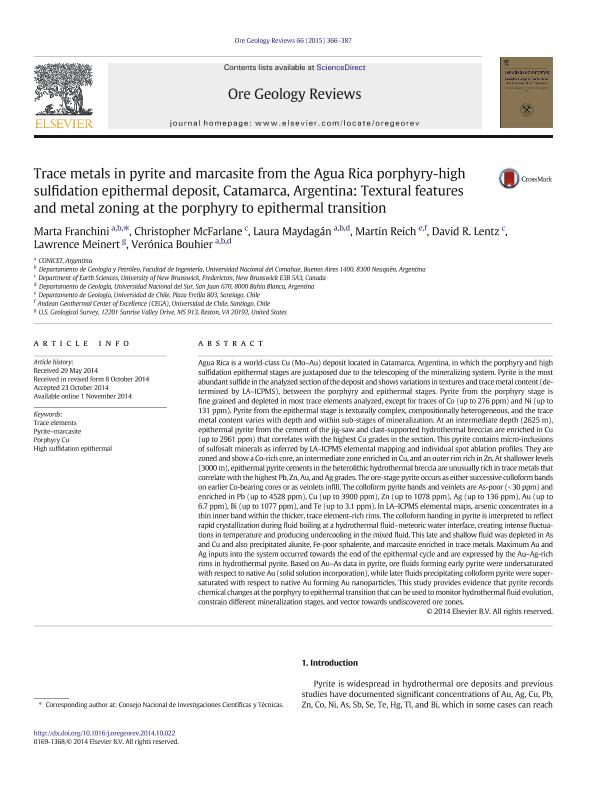Mostrar el registro sencillo del ítem
dc.contributor.author
Franchini, Marta Beatriz

dc.contributor.author
McFarlane, Christopher
dc.contributor.author
Maydagán, Laura

dc.contributor.author
Reich, Martin
dc.contributor.author
Lentz, David R.
dc.contributor.author
Meinert, Lawrence
dc.contributor.author
Bouhier, Verónica Emilia

dc.date.available
2018-03-19T19:36:20Z
dc.date.issued
2015-04
dc.identifier.citation
Franchini, Marta Beatriz; McFarlane, Christopher; Maydagán, Laura; Reich, Martin; Lentz, David R.; et al.; Trace metals in pyrite and marcasite from the Agua Rica porphyry-high sulfidation epithermal deposit, Catamarca, Argentina: Textural features and metal zoning at the porphyry to epithermal transition; Elsevier Science; Ore Geology Reviews; 66; 4-2015; 366-387
dc.identifier.issn
0169-1368
dc.identifier.uri
http://hdl.handle.net/11336/39255
dc.description.abstract
Agua Rica is a world-class Cu (Mo-Au) deposit located in Catamarca, Argentina, in which the porphyry and high sulfidation epithermal stages are juxtaposed due to the telescoping of the mineralizing system. Pyrite is the most abundant sulfide in the analyzed section of the deposit and shows variations in textures and trace metal content (determined by LA-ICPMS), between the porphyry and epithermal stages. Pyrite from the porphyry stage is fine grained and depleted in most trace elements analyzed, except for traces of Co (up to 276. ppm) and Ni (up to 131. ppm). Pyrite from the epithermal stage is texturally complex, compositionally heterogeneous, and the trace metal content varies with depth and within sub-stages of mineralization. At an intermediate depth (2625. m), epithermal pyrite from the cement of the jig-saw and clast-supported hydrothermal breccias are enriched in Cu (up to 2961. ppm) that correlates with the highest Cu grades in the section. This pyrite contains micro-inclusions of sulfosalt minerals as inferred by LA-ICPMS elemental mapping and individual spot ablation profiles. They are zoned and show a Co-rich core, an intermediate zone enriched in Cu, and an outer rim rich in Zn. At shallower levels (3000. m), epithermal pyrite cements in the heterolithic hydrothermal breccia are unusually rich in trace metals that correlate with the highest Pb, Zn, Au, and Ag grades. The ore-stage pyrite occurs as either successive colloform bands on earlier Co-bearing cores or as veinlets infill. The colloform pyrite bands and veinlets are As-poor (<. 30. ppm) and enriched in Pb (up to 4528. ppm), Cu (up to 3900. ppm), Zn (up to 1078. ppm), Ag (up to 136. ppm), Au (up to 6.7. ppm), Bi (up to 1077. ppm), and Te (up to 3.1. ppm). In LA-ICPMS elemental maps, arsenic concentrates in a thin inner band within the thicker, trace element-rich rims. The colloform banding in pyrite is interpreted to reflect rapid crystallization during fluid boiling at a hydrothermal fluid-meteoric water interface, creating intense fluctuations in temperature and producing undercooling in the mixed fluid. This late and shallow fluid was depleted in As and Cu and also precipitated alunite, Fe-poor sphalerite, and marcasite enriched in trace metals. Maximum Au and Ag inputs into the system occurred towards the end of the epithermal cycle and are expressed by the Au-Ag-rich rims in hydrothermal pyrite. Based on Au-As data in pyrite, ore fluids forming early pyrite were undersaturated with respect to native Au (solid solution incorporation), while later fluids precipitating colloform pyrite were supersaturated with respect to native Au forming Au nanoparticles. This study provides evidence that pyrite records chemical changes at the porphyry to epithermal transition that can be used to monitor hydrothermal fluid evolution, constrain different mineralization stages, and vector towards undiscovered ore zones.
dc.format
application/pdf
dc.language.iso
eng
dc.publisher
Elsevier Science

dc.rights
info:eu-repo/semantics/openAccess
dc.rights.uri
https://creativecommons.org/licenses/by-nc-sa/2.5/ar/
dc.subject
High Sulfidation Epithermal
dc.subject
Porphyry Cu
dc.subject
Pyrite-Marcasite
dc.subject
Trace Elements
dc.subject.classification
Meteorología y Ciencias Atmosféricas

dc.subject.classification
Ciencias de la Tierra y relacionadas con el Medio Ambiente

dc.subject.classification
CIENCIAS NATURALES Y EXACTAS

dc.title
Trace metals in pyrite and marcasite from the Agua Rica porphyry-high sulfidation epithermal deposit, Catamarca, Argentina: Textural features and metal zoning at the porphyry to epithermal transition
dc.type
info:eu-repo/semantics/article
dc.type
info:ar-repo/semantics/artículo
dc.type
info:eu-repo/semantics/publishedVersion
dc.date.updated
2018-01-23T14:03:20Z
dc.journal.volume
66
dc.journal.pagination
366-387
dc.journal.pais
Países Bajos

dc.journal.ciudad
Amsterdam
dc.description.fil
Fil: Franchini, Marta Beatriz. Consejo Nacional de Investigaciones Científicas y Técnicas; Argentina. Universidad Nacional del Comahue. Facultad de Ingeniería. Departamento de Geología y Petróleo; Argentina
dc.description.fil
Fil: McFarlane, Christopher. University of New Brunswick; Canadá
dc.description.fil
Fil: Maydagán, Laura. Consejo Nacional de Investigaciones Científicas y Técnicas; Argentina. Universidad Nacional del Comahue. Facultad de Ingeniería. Departamento de Geología y Petróleo; Argentina. Universidad Nacional del Sur. Departamento de Geología; Argentina
dc.description.fil
Fil: Reich, Martin. Universidad de Chile; Chile
dc.description.fil
Fil: Lentz, David R.. University of New Brunswick; Canadá
dc.description.fil
Fil: Meinert, Lawrence. U.S. Geological Survey; Estados Unidos
dc.description.fil
Fil: Bouhier, Verónica Emilia. Consejo Nacional de Investigaciones Científicas y Técnicas; Argentina. Universidad Nacional del Comahue. Facultad de Ingeniería. Departamento de Geología y Petróleo; Argentina. Universidad Nacional del Sur. Departamento de Geología; Argentina
dc.journal.title
Ore Geology Reviews

dc.relation.alternativeid
info:eu-repo/semantics/altIdentifier/doi/http://dx.doi.org/10.1016/j.oregeorev.2014.10.022
dc.relation.alternativeid
info:eu-repo/semantics/altIdentifier/url/https://www.sciencedirect.com/science/article/pii/S016913681400273X
Archivos asociados
